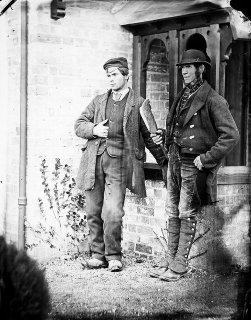IsaacAsmen
Member
- Joined
- Sep 29, 2020
- Messages
- 1
- Reaction score
- 0
Hello guys, It's my first post here, I know it stands out amongst the other topics but I hope you guys will play along.
I am a 2BA student at the Royal Academy of Antwerp in the fashion department, and same as every year we must start the year by recreating a historical costume, using authentic techniques, dyes, and research even down to the underwear.
To contrast with the very pretty and couture aspect a lot of people work on for this assignment ( victorian, baroque dresses, etc ) I wanted to work around " lower classes " and actually identically reproduce the outfit a poor working man would be wearing in the late 19th century.
So i chose to reproduce this costume ( find image below, guy on the left )
Its a picture of two working men, dated february 2nd 1870, in " Clonbrock Estate, Galway, Ireland " and is from a series of picture belonging to the family owning said estate, " the Dillon family ".
I already posted around a bunch of history forums and got my little investigation starting, someone suggested they don't look " super poor " since guy on the right is wearing a hat and a sort of frock coat. They also might have gotten their clothes from used clothes vendor. My questions for you guys today are :
- What kind of underwear do you think they would have been wearing ? Union suits? Chemise and long johns?
- What kind of boots the guy on the left is wearing ( they look like a mix between clogs and working boots )
- What kind of fabrics do you think they would be predominantly wearing ? seems like some sort of corduroy ensemble in left guy's case
- What kind of vest collar is this called, and would anybody have garment references for similar details in this period ?
Its pretty specific questions, but in reality, im interested in any thing , even anecdotes that could help me move to the next part of this research.
I know its not per say, " designer talk " , but I'm sure some fashion enthusiasts will be interested in taking part of this little investigation, as there is very little information on the subject online it will be a lot of guessing and comparing to other documents.
If you guys are interested, I'll post real time updates of the first toiles, prototypes of garments etc so you can be also a part of the project from its birth to its final realization
Hoping to get some answers,
Isaac
I am a 2BA student at the Royal Academy of Antwerp in the fashion department, and same as every year we must start the year by recreating a historical costume, using authentic techniques, dyes, and research even down to the underwear.
To contrast with the very pretty and couture aspect a lot of people work on for this assignment ( victorian, baroque dresses, etc ) I wanted to work around " lower classes " and actually identically reproduce the outfit a poor working man would be wearing in the late 19th century.
So i chose to reproduce this costume ( find image below, guy on the left )

Its a picture of two working men, dated february 2nd 1870, in " Clonbrock Estate, Galway, Ireland " and is from a series of picture belonging to the family owning said estate, " the Dillon family ".
I already posted around a bunch of history forums and got my little investigation starting, someone suggested they don't look " super poor " since guy on the right is wearing a hat and a sort of frock coat. They also might have gotten their clothes from used clothes vendor. My questions for you guys today are :
- What kind of underwear do you think they would have been wearing ? Union suits? Chemise and long johns?
- What kind of boots the guy on the left is wearing ( they look like a mix between clogs and working boots )
- What kind of fabrics do you think they would be predominantly wearing ? seems like some sort of corduroy ensemble in left guy's case
- What kind of vest collar is this called, and would anybody have garment references for similar details in this period ?
Its pretty specific questions, but in reality, im interested in any thing , even anecdotes that could help me move to the next part of this research.
I know its not per say, " designer talk " , but I'm sure some fashion enthusiasts will be interested in taking part of this little investigation, as there is very little information on the subject online it will be a lot of guessing and comparing to other documents.
If you guys are interested, I'll post real time updates of the first toiles, prototypes of garments etc so you can be also a part of the project from its birth to its final realization
Hoping to get some answers,
Isaac

